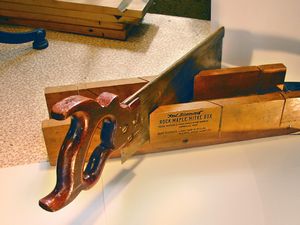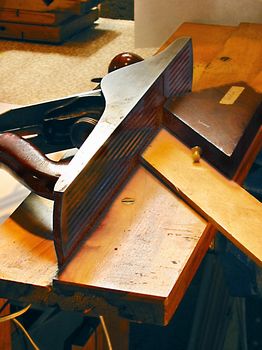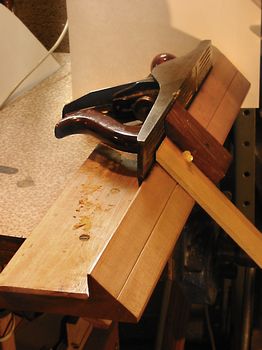We are all familiar with the mitre box for hand saws:

(Click any photo to enlarge.)
Use any saw as long as it doesn't have such big (& widely-set) teeth that it won't fit into the miter box slots without tearing them up. Accuracy is better with a backsaw (above) than an ordinary handsaw, because the extra backing at the top holds the backsaw blade straight and the teeth are finer. An ordinary cross-cut hand saw is 8 or 9 points (teeth per inch), but a backsaw might be 13 pt. Still, the cut is too rough for picture framing. What next?
The next step up in accuracy is using a hand plane and a jig called a "shooting board". A guide on the board enables the plane to shoot past the work repetitively, taking off a few thousandths of an inch on each pass. Search for "cut off saw" or a powered "mitre saw" in a shopping search engine if you need to do hundreds of cutoffs, but none will be any better than this, and the cost is $250 vs zero if you have some scrap hardwood. .

A standard ordinary miter shooting board (above) does the usual type of 45 deg mitre used in frames. Using an "ear" screwed onto the bottom of the board like the keel on a sailboat enables the shooting board to be clamped into the workbench vise. Otherwise, no clamping is needed -- it is easy to hold the work against the fence by hand.

45 deg cuts running the other way are done with a "donkey-eared" mitre shooting board. Even if you never build one, remember to tell at least one friend, "Hey, have you thought of trying a donkey-eared mitre shooting board?"
Lightly waxed, the wooden shooting boards will last a lifetime.
Shooting boards assume planes are flat on the sides as well as the bottom, and that sides meet bottom at 90 deg. Until you find a friendly small machine shop in town, you're going to have to shim the tool with pieces of masking tape -- if there's an improvised workaround for this kind of meatalworking, I haven't found it. Surface grinding is nicer than a garage that can turn (re-surface) the disks for disk brakes. You may need to make your own wooden clamping fixtures for your tools. In a post-industrial society, the consumer finishes the manufacturing.
JIN: need to add
--the little Xacto saw "We think of mitres for putting moldings around picture or an entire room, but model builders to all their cutting with them using tools like this:
--Assembling a frame goes faster with 2 or 4 corner clamps, especially if you need your other two hands to tack screws or staples into the joint. Some clamps have a miter saw guide built in -- one stone, 2 birds. If it's supposed to have right angles and you aren't using even a single right-angle clamp like one of these in the job, then use a diagonal. Before the glue goes on, add a diagonal piece of wood going from corner to corner of the workpiece, measured and screwed in to lock the workpiece into orthogonality. Do this even if you will have to cover up a pair of brad or finishing-nail holes with wood putty in the final work. A famous little table stands as an eternal monument to my failure to take this precaution -- another victory on one of those we-can-finish-this-TONIGHT!!! evenings.
--jerry